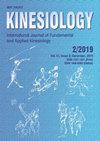特定耐力对青少年运动员足球小边比赛身体反应的影响
IF 0.9
4区 医学
Q4 REHABILITATION
引用次数: 0
摘要
本研究旨在比较不同专项耐力水平的足球运动员在根据运动员专项耐力平衡的团队进行SSG时的身体反应。来自参加全国比赛的18名U-17运动员参加了这项研究。采用Yo Yo间歇恢复测试2级(YIRT2)测定运动员的专项耐力。然后,根据运动员的位置状态和YIRT2得分,将他们平衡地分为两组:第一组是YIRT2成绩最高的运动员,第二组是YRIT2得分较低的运动员。运动员们与守门员进行了两场4分钟的3比3的小型比赛,并进行了4分钟的被动休息。通过每个运动员都担心的GPS设备获得了总覆盖距离、平均速度和加速度。与第2组相比,第1组表现出更高的总覆盖距离(大效应尺寸)、更高的平均速度(大效应大小)和更高的1 m·s-2以上加速度覆盖的总距离(中等效应尺寸)。我们得出的结论是,特定的耐力会部分影响年轻足球运动员在小型比赛中的身体反应。这些信息对于在训练过程中适当地规定小规模比赛很重要,可能是通过将具有相似特定耐力的运动员分组在一起,从而促进对适应条件的运动员的充分刺激。本文章由计算机程序翻译,如有差异,请以英文原文为准。
Effect of specific endurance on the physical responses of young athletes during soccer small-sided games
This
study aimed to compare the physical responses of soccer players with different
levels of specific endurance during SSG performed by teams balanced according
to athletes’ specific endurance. Eighteen U-17 athletes from a team that
participated in national competitions took part in this study. The Yo-Yo
Intermittent Recovery Test Level 2 (YIRT2) was used to measure the athletes’
specific endurance. Then, athletes were allocated to two groups balanced
according to their positional status and YIRT2 scores: in Group1 players with
the highest results in the YIRT2 and in Group 2 with the lower YIRT2 scores.
Athletes played two four-minute bouts of 3vs.3
small-sided games with goalkeepers with four minutes of passive rest. Total
distance covered, average speed, and accelerations were obtained by GPS devices
carried by each player. Group 1 presented higher total distance covered (large
effect size), higher average speed (large effect size), and higher total
distance covered in accelerations above 1 m·s-2 (moderate
effect size), compared to Group 2. We concluded that specific endurance can partially
influence physical responses of young soccer athletes during small-sided games.
This information is important to appropriately prescribe small-sided games
during the training process, possibly by grouping together athletes with
similar specific endurance and, therefore, promoting an adequate stimulus to
better-conditioned athletes.
求助全文
通过发布文献求助,成功后即可免费获取论文全文。
去求助
来源期刊

Kinesiology
REHABILITATION-SPORT SCIENCES
CiteScore
1.90
自引率
8.30%
发文量
16
审稿时长
>12 weeks
期刊介绍:
Kinesiology – International Journal of Fundamental and Applied Kinesiology (print ISSN 1331- 1441, online ISSN 1848-638X) publishes twice a year scientific papers and other written material from kinesiology (a scientific discipline which investigates art and science of human movement; in the meaning and scope close to the idiom “sport sciences”) and other adjacent human sciences focused on sport and exercise, primarily from anthropology (biological and cultural alike), medicine, sociology, psychology, natural sciences and mathematics applied to sport in its broadest sense, history, and others. Contributions of high scientific interest, including also results of theoretical analyses and their practical application in physical education, sport, physical recreation and kinesitherapy, are accepted for publication. The following sections define the scope of the journal: Sport and sports activities, Physical education, Recreation/leisure, Kinesiological anthropology, Training methods, Biology of sport and exercise, Sports medicine and physiology of sport, Biomechanics, History of sport and Book reviews with news.
 求助内容:
求助内容: 应助结果提醒方式:
应助结果提醒方式:


